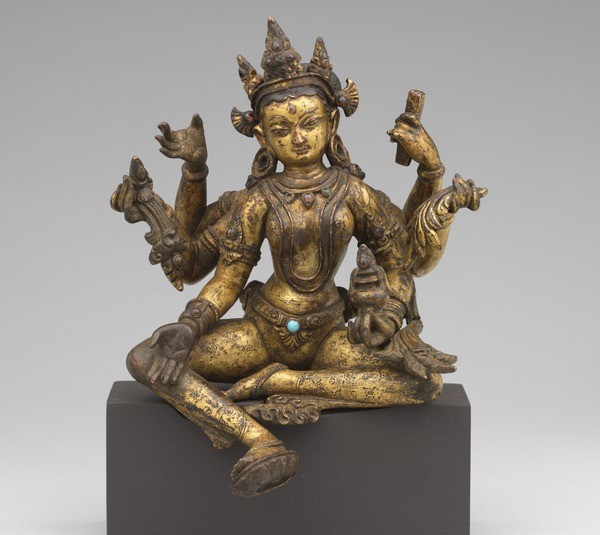
Every March in the United States, we celebrate Women’s History Month, a time to reflect on the important contributions and role of women in shaping our society and everyday lives.
Throughout the religious history of the Himalayas and South Asia, women have been revered for their creative and spiritual powers. In Hinduism, the Sanskrit term shakti refers to the all-pervading feminine energy that creates life and animates all existence. Each Hindu goddess represents a personification of shakti in its many manifestations, from loving mother to raging warrior. In Himalayan Buddhism, the feminine also represents wisdom, one of the two aspects required for enlightenment.
Through March and beyond, we invite you to reflect on the sculptures and paintings in our galleries that depict powerful female figures from the Himalayas, and Hindu and Buddhist cultures.
Check out a selection below and keep an eye out for them next time you visit the Museum.
On Display in Gateway to Himalayan Art

One of the most popular deities in the Himalayas, Green Tara sits in the pose of royal ease with her right hand extended in the gesture of supreme generosity. She is a protector and a provider and has her right leg extended so she can get up at any time and help her followers.

In this sculpture, Shiva sits supporting the multi-armed and multi-headed Siddha Lakshmi. In a reversal of traditional gender roles, Siddha Lakshmi acts as a guru while Shiva, in turn, is her disciple and attempts to understand her ultimate wisdom.

This sculpture depicts Vajradhara in union with his consort Bhagvani; the couple represents the two aspects of enlightenment: compassion (Vajradhara) and wisdom (Bhagvani). Bhagvani also represents Vajradhara’s “shakti” or power; Vajradhara would not be able to achieve enlightenment without her.

Considered by many to be the ultimate tantric female buddha, Vajrayogini stands in an active warrior pose with large breasts and wide hips. She tramples two figures under her feet as a visual metaphor for overcoming the ego.

This sculpture depicts the Indian goddess Shri Devi, whose violent appearance is really a manifestation of her boundless compassion. The arsenal of magical weapons hanging from her mule’s harness include a bag of diseases, and a ball made up of five colored threads, the latter used to bind enemies of the faith.

Tantric goddess Guhyakali is a favorite in Nepal and is known as one of the Eight Mother Goddesses and the Nine Durgas. At the base of the strut, a lotus supports her and her lion mount. Behind her are flowering trees, creating a canopy of blossoms.

On Display in Masterworks of Himalayan Art

This elegant bronze of Green Tara showcases early Tibetan aesthetics and metal sculpture. Tara is the most prominent Female Buddha of Northern Buddhism and maintains important place on temple and home shrines.

The goddess Marichi (known as Goddess of the Dawn) is rooted in the metaphor of light overcoming darkness, representing the fruitfulness of meditation and spiritual practice. This form was one of two attendants accompanying a sculpture of the goddess Tara.

This sculpture of Tara is attributed to the Tenth Karmapa, Choying Dorje (1604-1674), a unique and eccentric figure within the history of Tibetan art. Notable features include a pair of birds framed in leaves above Tara’s head.

This small metal sculpture comes from the Himalayan region of Kashmir. It depicts Parvati, the daughter of the Himalayan mountains and the wife of the Hindu god Shiva.

In Hinduism, Parvati is the goddess of fertility, love, but also divine strength and power. She is often paired together with Shiva to represent the universal principles of male and female.

This stone stele depicts the Indian folk goddess Manasa, who is worshiped for her ability to prevent and cure snakebites. She promotes fertility and agricultural prosperity and defends against infectious diseases.

This painting depicts Tantric deity Vajravarahi, standing in her iconic dancing posture, surrounded by seven yoginis of different colors.

Magzor Gyalmo, Queen Who Repels Armies, is understood to be female protector deity. Fierce in appearance she holds aloft a stick in the right hand and a skullcup to the heart in the left while riding a mule over a pool of blood.
On Display in the Tibetan Buddhist Shrine Room

In this painting, Tara is protecting humans from the Eight Fears. Each vignette depicts Tara intervening and averting tragedies, such as elephant stampedes and drowning.



This 17th-century sculpture of Vajrayogini presents her as a completely enlightened Buddha in female form. Considered the consort of the tantric deity Chakrasamvara, Vajrayogini developed her own following during the later medieval period in India and then substantially in Himalayas. Though this particular form is associated with the Sakya school, she can be found across all Buddhist schools of Himalayan Buddhism.
On Display in Nepalese Seasons: Rain and Ritual



.jpg)
This sculpture shows the divine feminine Durga slaying the buffalo demon Mahisha. According to legend, Mahisha terrorized the world because he thought he was superior to all other beings. In order to bring him to justice, the gods combined their power to form Durga, who put a stop to his egotistical rampage. Though we may not have the same divine power as Durga, when we combine our efforts, we can create collective change.
Learn more about female figures in Himalayan art at an upcoming Female Empowerment Tour, every Wednesday evening in March.
Add Your Thoughts
Comments are moderated, and will not appear on this site until the Rubin has approved them.


